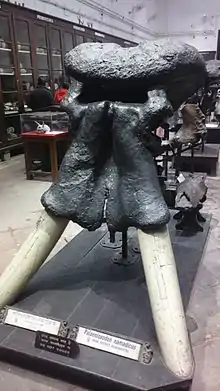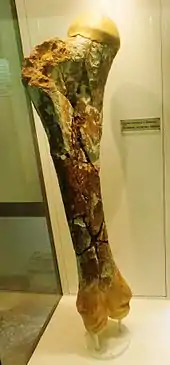Palaeoloxodon namadicus
Palaeoloxodon namadicus or the Asian straight-tusked elephant, was a species of prehistoric elephant that ranged throughout Pleistocene Asia, from India (where it was first discovered) to Japan.
| Asian straight-tusked elephant Temporal range: Late Pleistocene | |
|---|---|
 | |
| Scientific classification | |
| Kingdom: | Animalia |
| Phylum: | Chordata |
| Class: | Mammalia |
| Order: | Proboscidea |
| Family: | Elephantidae |
| Genus: | †Palaeoloxodon |
| Species: | †P. namadicus |
| Binomial name | |
| †Palaeoloxodon namadicus | |
Some authorities regard it to be a subspecies of Palaeoloxodon antiquus, the straight-tusked elephant, due to extreme similarities of the tusks. Their skull structure was also different from that of a modern elephant. The grouping of this genus is supported by cranial synapomorphies with other species of Palaeoloxodon.[1] Later research suggested that P. namadicus can be distinguished from P. antiquus by its less robust limb bones and more stout cranium.[2]
Palaeoloxodon namadicus is thought to have died out around 24,000 years ago, near the end of the Pleistocene. A late record of 56 kya BP is known from the Ganga plain in India.[3] In 2015, a study based on extensive research of fragmentary leg bone fossils suggested that P. namadicus may have been the largest land mammal ever.[4]
Size

Several studies have attempted to estimate the size of the Asian straight-tusked elephants, as well as other prehistoric proboscideans, usually using comparisons of thigh bone length and knowledge of relative growth rates to estimate the size of incomplete skeletons.
One partial skeleton found in India in 1905 had thigh bones that likely measured 165 centimetres (5.41 ft) when complete, suggesting a total shoulder height of 4.5 metres (14.8 ft) for this individual elephant.
Two partial thigh bones were found in the 19th century and would have measured 160 cm (5.2 ft) when complete. A fragment from the same locality was said to be almost a quarter larger; volumetric analysis then yields a size estimate of 5.2 metres (17.1 ft) tall at the shoulder and 19.5 tonnes (21.5 short tons) in weight.[5]

References
- Ferretti, M.P. (May 2008). "The dwarf elephant Palaeoloxodon mnaidriensis from Puntali Cave, Carini (Sicily; late Middle Pleistocene): Anatomy, systematics and phylogenetic relationships". Quaternary International. 182 (1): 90–108. Bibcode:2008QuInt.182...90F. doi:10.1016/j.quaint.2007.11.003.
- Larramendi, Asier; Zhang, Hanwen; Palombo, Maria Rita; Ferretti, Marco P. (February 2020). "The evolution of Palaeoloxodon skull structure: Disentangling phylogenetic, sexually dimorphic, ontogenetic, and allometric morphological signals". Quaternary Science Reviews. 229: 106090. Bibcode:2020QSRv..22906090L. doi:10.1016/j.quascirev.2019.106090.
- Ghosh, Rupa; Sehgal, R. K.; Srivastava, Pradeep; Shukla, U. K.; Nanda, A. C.; Singh, D. S. (November 2016). "Discovery of Elephas cf. namadicus from the late Pleistocene strata of Marginal Ganga Plain". Journal of the Geological Society of India. 88 (5): 559–568. doi:10.1007/s12594-016-0521-7. ISSN 0016-7622.
- "An Ancient Elephant May Have Been Biggest Land Mammal Ever". 2015-07-17. Retrieved 2017-04-21.
- Larramendi, Asier (2015). "Proboscideans: Shoulder Height, Body Mass and Shape". Acta Palaeontologica Polonica. doi:10.4202/app.00136.2014.